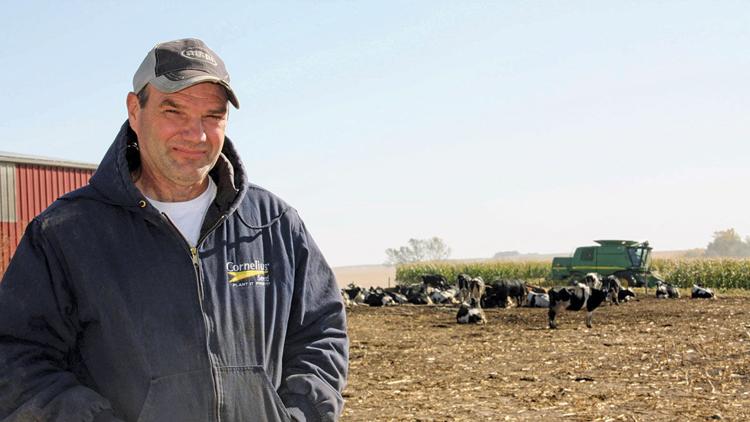
“In April I got the worst milk check per hundredweight that I ever got in my life, and in July I got the best milk check I ever got in my life,” Carroll said. “The volatility on the milk market is unbelievable.”
He was paid $9/cwt. in April and almost $25/cwt. in July.
Dairy farms next door to each other could receive a $5 to $6 per hundredweight difference in their milk checks.
“It depends on what their milk is processed into and what co-op or processor they are selling to,” Carroll said. “That’s what’s causing the negative producer price differentials.”
Carroll, his wife, Jamie, and sons Brent and Brady milk 140 cows in a double-six herringbone parlor and grow 400 acres of corn, oats and hay. Rye cover crops seeded in the fall are grazed each spring. They feed out their steers and buy a few more that they finish.
Carroll understands the intricacies of milk pricing on the farm but also from the processing end as a member of the AMPI corporate board. He sits on the Iowa State Dairy Association and Midwest Dairy Association boards and the National Dairy Promotion and Research Board.
When COVID first hit, Carroll and his family had to reassess how they did everything on the dairy farm.
“You stayed home a lot more, and you had to consider how you were going to handle the milk truck coming in and different people coming on and off your farm on a daily basis,” he said. “In the beginning nobody knew what we needed to do and what precautions we had to take. For example, how did you handle going to get parts or supplies?”
They worked through a lot of those things but are still cautious, Carroll said.
As cooperatives and processors responded to the dramatic changes taking place due to shutdowns, some dairy farmers had to dump milk for a short period of time.
“At AMPI we had enough processing capacity and customer demand that we did not have to dump any milk,” Carroll said. “That said, there wasn’t room to welcome new members, and if anyone is planning to expand, they need to be talking to their co-op.”
When prices dropped in April, Carroll said everyone was on pins and needles not knowing how long it was going to last, fully aware they couldn’t survive at that level for long. There was talk of federal relief, but nothing was guaranteed at the time.
“Like good farmers, we just pushed ahead and put in the crop,” Carroll said. “We were essential workers, and we had to keep going.”
Dairy Margin Coverage payments have really helped this year, and the Coronavirus Food Assistance Program payments made it possible to keep current on bills, Carroll said.
Pandemic pivot
Prior to the pandemic, half the dairy products in the United States were consumed through food service. When the pandemic closed restaurants and schools, dairy products had to be repackaged for consumers. That reconfiguring left a lot of equipment sitting idle.
USDA’s Farmers to Families Food Box Program helped in getting food service-ready packages to the consumer so they could use dairy products, Carroll said. Midwest Dairy Association provided grants to food banks and schools for refrigeration so they can keep dairy products on their shelves.
“The food box program filled a need,” Carroll said.
He participated in a meeting Oct. 14 with USDA Undersecretary Bill Northey and Iowa Secretary of Agriculture Mike Naig, where he and other dairy producers shared their frustrations with dairy price turbulence.
“I felt like he (Northey) really wanted to listen to what we had to say,” Carroll said.
“2020 has been anything but what we expected it to be a year ago,” said Marin Bozic, assistant professor of applied economics at the University of Minnesota. “We have seen some of the lowest prices since we have been tracking spot markets for dairy products.”
In April and early May when the food service sector shut down, there was a large surplus of milk that was depressing prices and also led to widespread dumping of milk for a brief period of time, Bozic said.
“Robust government intervention through the Farmers to Families Food Box Program as well as strong exports, and to some extent recovering food service in addition to some supply management programs implemented in some parts of the country led to the fast recovery of dairy markets beginning in late May and early June, and it is still going on with record high cheese prices,” Bozic said.
Looking ahead
Looking to 2021, farmers need to make use of available risk management tools. Dairy Margin Coverage, a farm bill program targeting smaller dairy producers up to 200 cows, is open for sign up through mid-December.
“I’ve done the analysis of the new program and in my opinion everybody should sign up,” Bozic said.
For larger farms, he recommends farmers look at Livestock Gross Margin for Dairy Cattle and Dairy Revenue Protection.
Bozic expects subdued cheese prices in 2021.
“We have large increases in cheese manufacturing capacity coming on line very soon,” Bozic said. “That is going to displace some of the current sales and depress cheddar cheese prices in the United States.”
The current $2.70 cheddar cheese price could reach $1.30 to $1.40 by late spring.
He warns the help producers received in 2020 in the form of Coronavirus Food Assistance payments and the food box program is likely to be curtailed.
“These support programs are not just the result of coronavirus, they are also the result of us having presidential, Senate and House elections,” Bozic said. “We know there won’t be as much incentive to continue with such ad hoc help in 2021.”
While there were hopes the economy would come back roaring from the COVID-19 recession, every day there is more information indicating a prolonged recession, Bozic said.
“All that may suggest some potential weakness in demand for dairy products,” he said. “There is a reason to make sure your bottom line is protected, and we have wonderful tools available for dairy producers to do that this year.”

























